Ordinary rate delivery form AE-DO-1.
- Home, index, site details
- Australia 1901-1988
- New South Wales
- Queensland
- South Australia
- Tasmania
- Victoria
- Western Australia
- International
- Special aspects
| Heading and notes: | Form number E.T. No. 2 (but not printed on the first three formats). Combined form and delivery envelope format. |
| Message area: | Blank. |
| Reverse side: | Blank. |
| Colours (text & form): | Black on green (but many variations of green). |
| Size of form overall: | 188 × 201 mm. |
| Size of datestamp box: | 26 × 22 mm (3rd format only). |
- has flaps at the top and on the left side in the top left section;
- the main distinctions amongst the varieties are:
1A: TELEGRAM in thick serif font and pointing hand at top;
1B: TELEGRAM in thick serif font and pointing arrow at top;
1C: TELEGRAM in sans serif font (also for the following printings) and there is a box for the date stamp at the right;
1D: "Date stamp" heading at the right but no box;
1E: "Date Stamp" on the left side just below TELEGRAM.
The form was folded along printed lines and then sealed with gummed tabs so that the message area was completely enclosed. It was opened by tearing along the gummed tabs - not always an easy task. The folded form was very small - see below. Urgent rate forms with the same design were also printed.
For some reason, the trial using the experimental forms was considered to be a success. So, in April 1918, the Post Office Monthly Circular contained the following:
TELEGRAPH: Combined Form and Envelope.
Approval has been given that the use of the combined telegraph form be extended to all offices throughout the Commonwealth, but the existing supply of forms and envelopes should be used up to prevent waste.
Five versions were printed over the next few years. The forms were however unpopular by all concerned:
- the telegraphists had difficulties using them in typewriters;
- the messengers and postmen found the small size difficult to handle;
- recipients found them difficult to open without damaging the message or the form in general.
An example of the public opposition to the format is reflected by the account reprinted in a number of newspapers including the Mullumbimby Star of 10 July 1919:
Folded Telegram Form.
"Convenience or economy as represented in the telegram — or 'puzzlegram' as it is facetiously termed by flippant critics — was the subject of passing reference in the House of Representatives on Wednesday. Mr. Higgs (Q.) desired information as to when the ridiculous folding telegram form produced through the genius of Mr Webster was to be abolished and another form substituted whereby the taxpayer might have a reasonable chance of reading the telegram when he received it. The Postmaster-General, states the Age, assumed an air of calm indifference. Further provoked by Mr. Higgs, however he protested that the telegram form at present utilised represented a saving of £7000 a year. "And the loss of 7000 souls" said the Queensland member".
In the Federal Parliament sitting of the House of Representatives on 21 April 1920, Dr. Earle Page (N.S.W.) was "informed ...of the suggestion that the use of envelopes for telegrams be reverted to".
In addition to the public's negative reaction, new printing equipment was being purchased which could not easily accommodate the more complex design easily. The combined forms were therefore abandoned about 1921 as is shown by the following announcement in the April 1921 Post Office Monthly Circular:
... it is hereby notified that it has been decided to discontinue the use of the combined form and envelope when the present supplies are exhausted, and revert to the previous system.
The press release appearing in many newspapers was as follows:
"End of Self-folding Telegram Form.
Instructions have been issued by the Postmaster-General that, as soon as the supply of forms at present in stock has been exhausted, the old system of dealing with telegrams for delivery is to be reverted to. The now well-known green, self-folding forms were introduced as an economy measure, but it is considered that the saving effected, if any, does not justify the inconvenience caused by the folded telegram. Experience has prompted the decision to revert to the former system of a plain telegram form and an envelope".
| No image yet available. | AE-DO-1A.
Characteristics:
This form may have been trialled in NSW. |
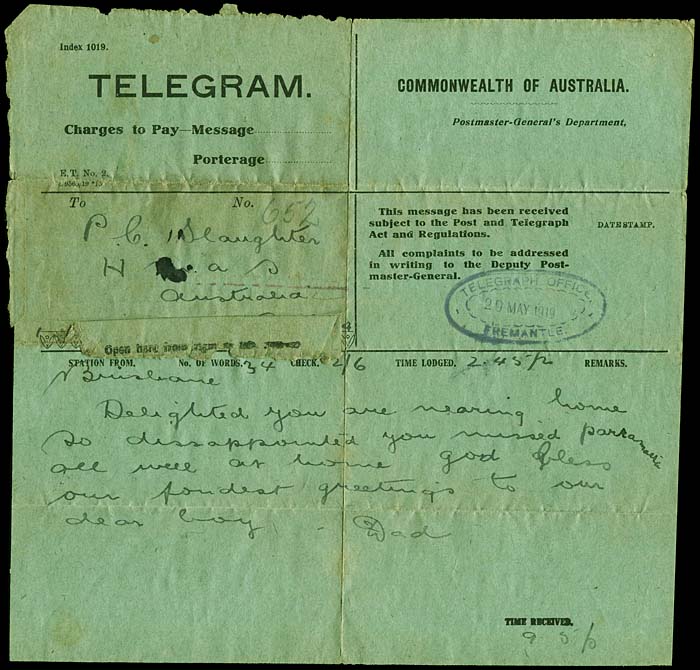 |
AE-DO-1B.
Brisbane to H.M.A.S Australia at Fremantle, WA. Characteristics:
This form may have been printed and trialled in Western Australia. See also the reference in the Table at the base of this form for AE-DO-1D where this is another form included for HMAS Australia. |
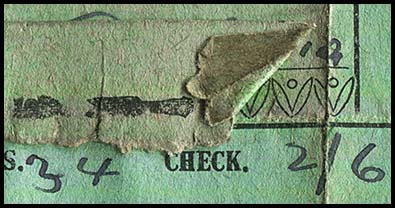 |
Detail from the above scan of:
|
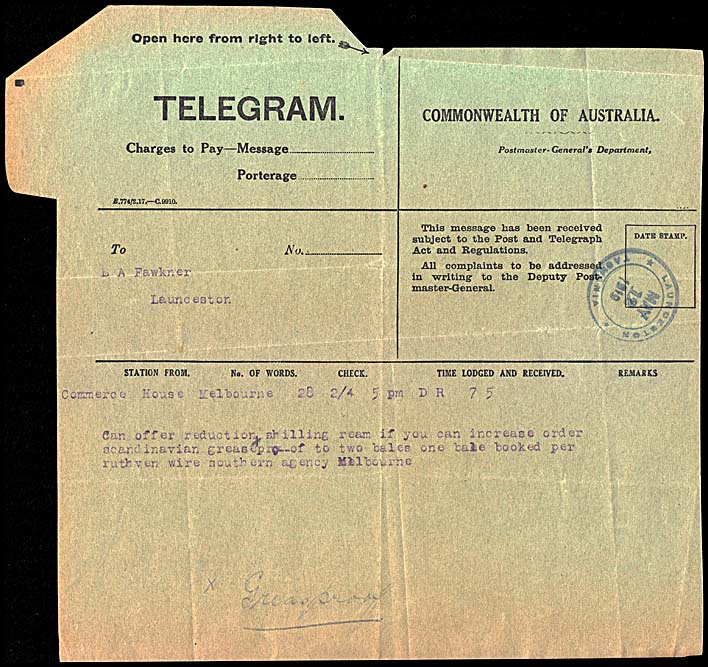 Printed February 1917. |
AE-DO-1C.
Melbourne to Launceston Has type 2A (iv) rubber date stamp which is rated RRR. Characteristics:
|
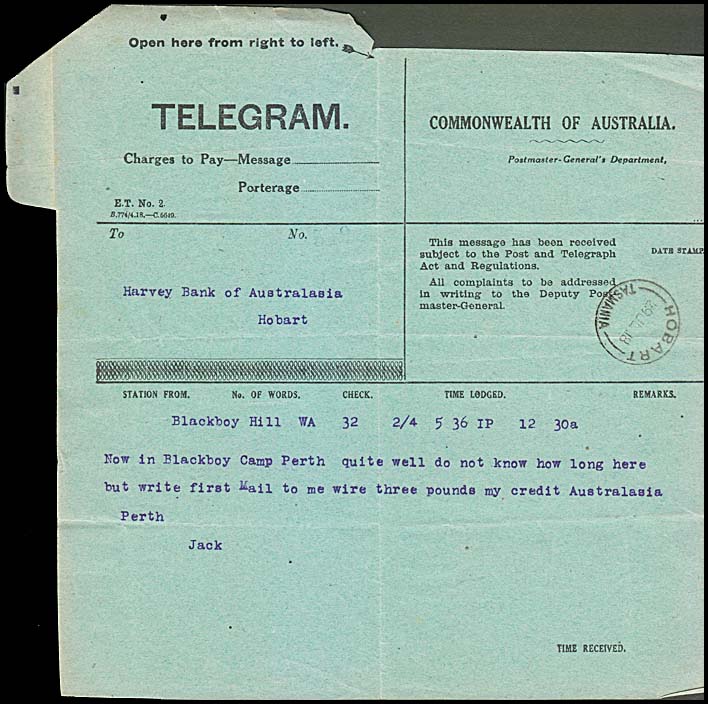 Printed in April 1918. |
AE-DO-1Da.
Hobart for local delivery Characteristics:
|
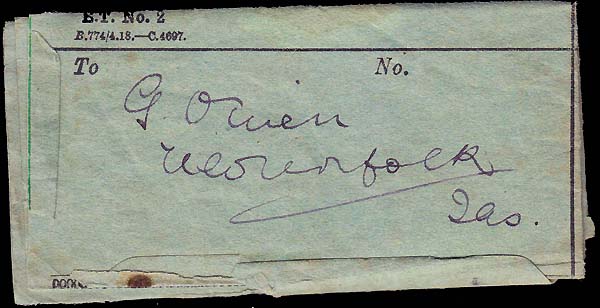 Printed in April 1918 (and with same schedule number as the previous form). |
AE-DO-1D.
Quarantine Station to New Norfolk (26 July 1919). Folded to demonstrate the appearance. This is the version printed on blue-green paper. |
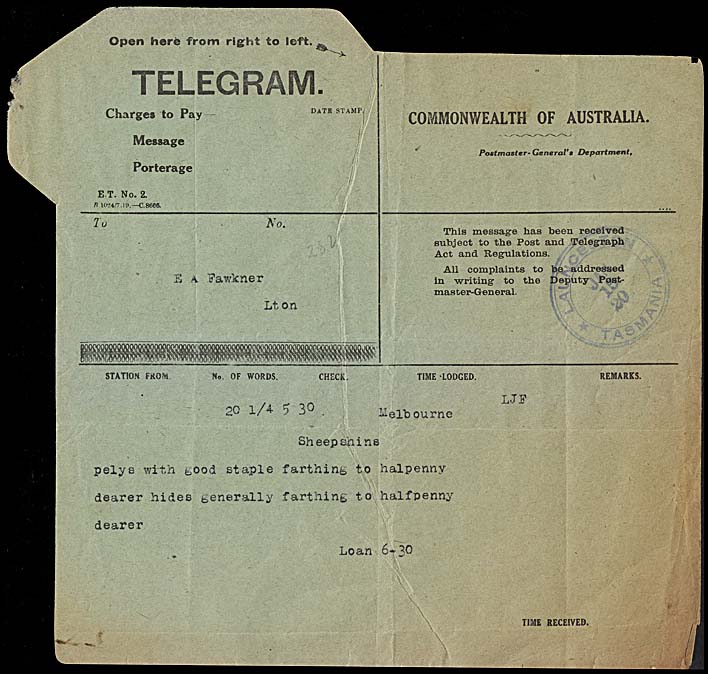 Printed July 1919. |
AE-DO-1Ea.
Melbourne to Launceston Has type 2A (v) rubber date stamp which is rated RRR. Characteristics:
Printed in a range of shades from light green to green-blue. |
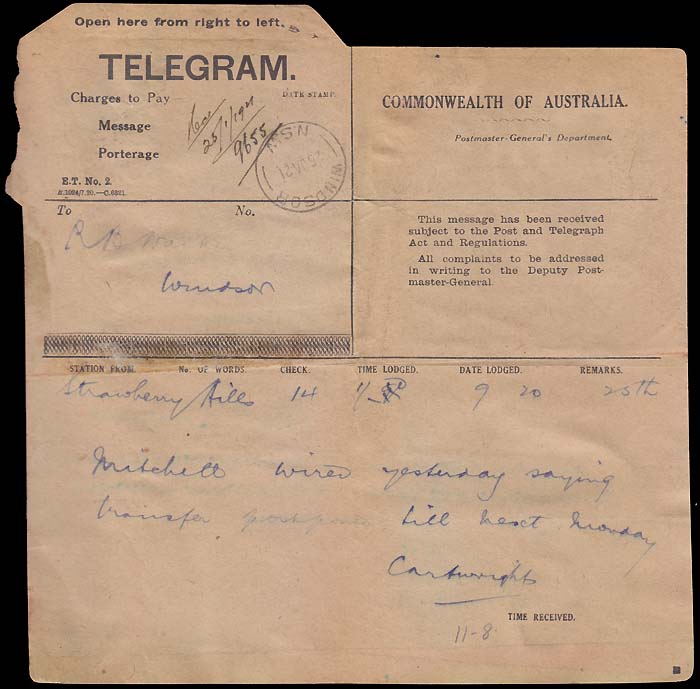 Printed July 1920. |
AE-DO-1Eb.
Strawberry Hills to Windsor, NSW (25 January 1921). Characteristics:
Given the schedule number is the same as for DO-1Ea and the date of use, this form may have been printed on different paper at the end of printing because the usual paper stock had been exhausted. Only three examples of this type have been cited (see a Kalgoorlie date stamp - with North removed - for a second example). |
Details of use and rarity.
| Form sub-number |
Schedule number | Earliest recorded date | Rarity rating |
| DO-1A | Print number 25934 and St 7427. (H) | 1 November 1918 at Cootamundra. | RRR |
| DO-1B | Index 1019 and L 9565/19*15. | 29 May 1919 at Fremantle, WA. Sent from (HMAS Australia). |
RRR |
| DO-1C | B.774/2.17. - C.1823. | 28 June 1917 at CETO Melbourne. | RR |
| B.774/2.17. - C.9910. | 8 April 1918 at Adelaide. | RR | |
| DO-1Da | B.774/2.17. - C.3034. | 8 April 1919 at Rockdale, NSW. | R |
| B.774/4.18 - C.4697 | 12 June 1919 at Port Melbourne, Vic. Sent from (HMAS Australia). | R | |
| B. 774/4.18. - C.5649. | 29 July 1918 at Hobart. | R | |
| B.774/2.19. - C.1590. | 20 June 1919 at CETO Melbourne. | R | |
| DO-1Db | L 9565/19 * 15 | 29 May 1919 at Fremantle | RRR |
| DO-1Ea | B.1024/7.19. - C.8666. | 21 October 1919 at CETO Melbourne. | NC |
| B.1024/12.19. - C.18843. | 17 July 1920 at Burnley, Vic. | NC | |
| B.1024/7.20. - C.6321. | 16 November 1920 at Maryborough, Qld. | NC | |
| DO-1Eb | B.1024/7.20. - C.6321. | 25 January 1921 at Windsor, NSW. | RRR |